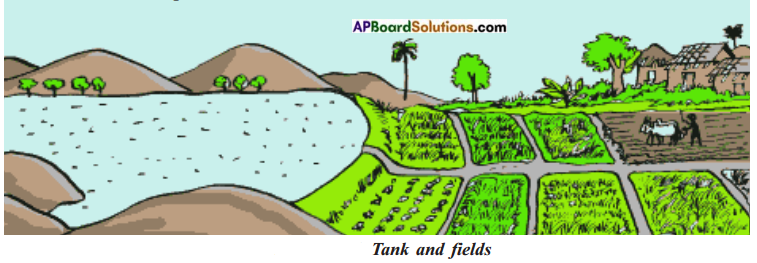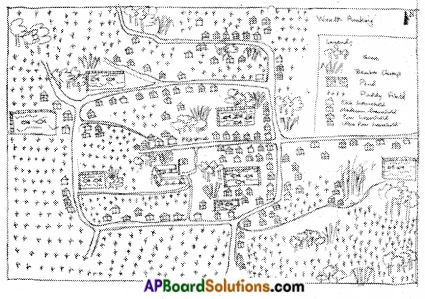SCERT AP Board 7th Class Social Solutions 3rd Lesson Tanks and Ground Water Textbook Questions and Answers.
AP State Syllabus 7th Class Social Studies Solutions 3rd Lesson Tanks and Ground Water
7th Class Social Studies 3rd Lesson Tanks and Ground Water Textbook Questions and Answers
Improve Your Learning
Question 1.
Correct the incorrect sentences:
a) Water flows from the plains to the plateau. (✕)
Answer:
Water flows from the plateau to the plains.
b) There is a thick deposit of sand and gravel in the plains. (✕)
Answer:
There is a thick deposit of alluvium in the plains.
c) Groundwater will never dry. (✕)
Answer:
Groundwater will dry sometime.
d) It is easy to dig wells in Rajahmundry. (✓)
Answer:
Correct
![]()
Question 2.
The wells shown in this figure are situated on the plains of the Godavari. But there seems to be a mistake in the figure. Can you correct it?

Answer:
The water level should be the same.
Question 3.
In which of these places do you expect maximum percolation to take place?

Answer:
B
Question 4.
When the owners of some wells in Pallerla started using high-powered motors to draw water from the wells, the owners of other wells noticed that their wells were drying up. Discuss the possible solution to the problem.
Answer:
The owners of other wells should resist that owner from using high-power motors. And the owner also should take necessary preventive steps to store rainwater/ underground water.
![]()
Question 5.
In areas where there is a shortage of groundwater, should there be any restrictions on digging tube wells? Why?
Answer:
The areas which have a shortage of groundwater are stated as notified areas by Central Ground Water Authority. In these areas, there is permission for only one tube well to meet the drinking and domestic purpose of water, its diameter should be 100 mm, and the capacity of the pump should not exceed 1 HP. It should have a rainwater harvesting system on the premises. Otherwise, the ‘holding capacity in the matter inside the earth will be lessened.
Question 6.
Think about the ways to restore the groundwater in your area?
Answer:
In our area also people draw more water from the ground, so the groundwater is decreasing over time. I think the following steps are useful to enhance groundwater
- Vegetation like trees and grasses and bunds are used to enhance groundwater.
- We follow watershed development projects.
- Under these projects trees and grasses are planted on the hill slopes from where a stream starts and small bunds are built across streams to stop the flow of water.
- I suggest the people store rainwater in tanks and not dig wells too deep in the ground.
- I think tanks should be developed in our village which helps the people not only in giving them and their animals drinking water, but also irrigating their fields in such a way that even in drought years people could raise at least some crops.
![]()
Question 7.
Observe the following picture and compare it with your locality.

Answer:
Our village is ‘Kalisipudi’ village in West Godavari District. There are no hills around our village like here. We have two water tanks – one is for drinking water and the another is for cultivation. Rainwater is saved in one tank. Water from* the canal, which was dug from the river Godavari, will be turned to another tank. Our farmers use tractors for ploughing. Our residences are far away from our fields. Draw the map of your village and locate the water resources of your village in it.
Question 8.
Draw the map of your village and locate the water resources of your village in it.
Answer:
A village picture – (with well, water tank)

Question 9.
Read the third para of page 27 and write a comment on it.
Water quickly flows into streams and into rivers. However, if the flow of the j rainwater were to be checked by vegetation or bunds, then there would be a greater possibility of the water percolating into the soil to join the groundwater.
Answer:
After runoff comes the last step of the water cycle, percolation.
Percolation occurs when the water on the earth’s surface in the run-off stage seeps underground. That is why in the old days they used wells to retrieve water.
![]()
Project
Collect the following information about the tanks/kuntas.

Answer:
Students’ Activity.